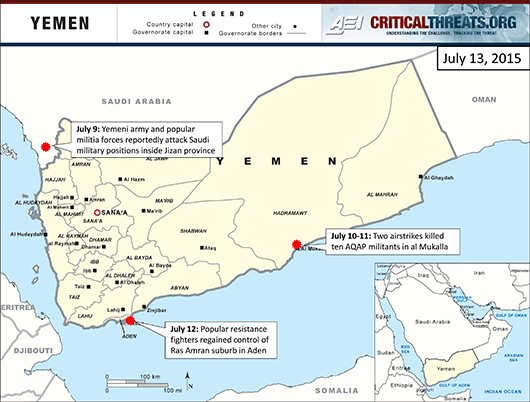The collapse of the UN-negotiated ceasefire within hours of its start will prevent necessary humanitarian assistance from entering the country, but has also permitted local anti-al Houthi groups to regain control of territory. The continuation of the crisis in Yemen will further cement fracture lines already running throughout the country. Further, an announced escalation from the al Houthis could significantly expand the Yemeni conflict.
The expected humanitarian ceasefire in Yemen did not hold, with both sides exchanging blame for its collapse. The UN-negotiated ceasefire was to begin just before midnight on July 10, but residents report that Saudi Arabia-led coalition airstrikes hit targets in Sana’a early on July 11 and that fighting continued in major cities such as Taiz, where forces opposed to the al Houthis have had recent successes, and Aden. Anti-al Houthi forces in Aden reportedly took back the Ras Amran suburb on July 12 as coalition airstrikes also struck al Anad military base in Lahij governorate, held by the al Houthis since late March. The ceasefire was supposed to give humanitarian agencies access to import and deliver critical assistance, including food and medical supplies, to Yemenis. The continued fighting places major constraints on aid delivery. The majority of imports into Yemen are now arriving through the al Houthi-controlled al Hudaydah port.
Al Houthi leader Abdul Malik al Houthi threatened an escalation against Saudi Arabia in his speech delivered on Quds Day. Quds, or Jerusalem, Day is a holiday began by Iran that is celebrated on the last Friday of Ramadan to express solidarity with the Palestinians. Abdul Malik al Houthi said in a broadcasted speech on July 10, “We will take strategic measures which will change the topography of the region” if Saudi Arabia’s “aggression” continues. How the al Houthis intend to escalate the conflict is not clear. The Yemeni army, affiliated now with the al Houthis, attacked military positions inside Saudi Arabia in Jizan province alongside popular militia forces on July 9. Iranian Supreme Leader Ayatollah Ali Khamenei associated the Saudi Arabia-led coalition air campaign with Saudi Arabia’s anger over Iranian influence in the region in July 11 remarks in Tehran.
Al Qaeda in the Arabian Peninsula (AQAP) leader Qasim al Raymi pledged allegiance to al Qaeda leader Ayman al Zawahiri and called for Muslims to rise up against the U.S. Raymi, who succeeded the late leader Nasser al Wahayshi, pledged bayat to Zawahiri, confirming AQAP’s continued role in the al Qaeda network. He described the U.S. as “stumbling” and as allied with the Shia, including the al Houthis. Jihad, said Raymi, is the solution. (Statement obtained and translated by SITE.) Separately, pro-AQAP Twitter accounts are reporting that media official Abu Hajir al Hadrami was killed in a recent airstrike, very likely one of the two that occurred in al Mukalla, Hadramawt, late on July 10 and early July 11. An airstrike targeted AQAP members traveling in a car and a second airstrike targeted an arms container. The airstrikes killed ten AQAP members, including three local leaders.
The Yemeni state is fractured and local groups, particularly in Aden, are becoming strong outside of a central state system. This development may increase the likelihood of localized truces that enable the delivery of humanitarian assistance, but will also increase the challenge of eventually uniting Yemen under a single government again. AQAP has been taking steps in eastern Yemen to integrate into local governance structures, strengthening its base in the country.
Joshua Koontz contributed research for this publication.
← PREVIOUS |
NEXT → |

